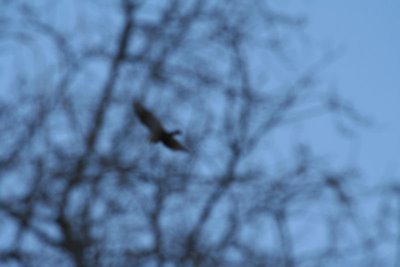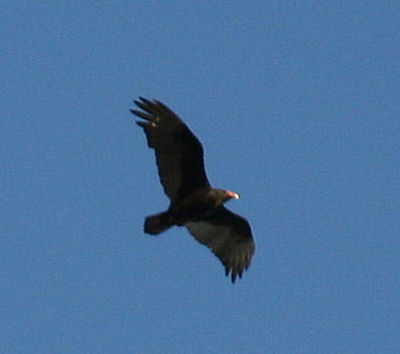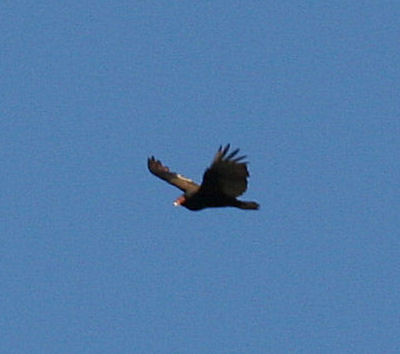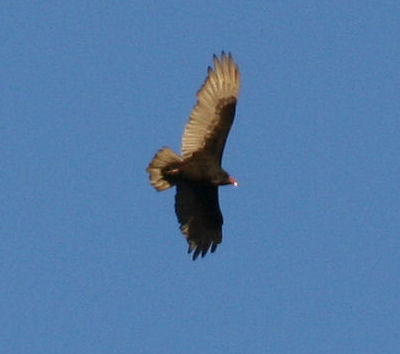
The turkey vulture, Cathartes aura, is a large bird, about 25-32 inches (64-81 cm) in length, with a 67-70 inches (170-178 cm) wing span. It feeds on carrion, using its sense of smell to locate its food. It has a heightened sense of smell that allows it to find carrion even underneath a forest canopy. The turkey vulture breeds in summer from southern Canada through the United states and southward. They are not found in the Great Plains. In winter, it stays in northern California, Mexican border, eastern Texas, southern Missouri, and southern New York southward throughout the southeastern United States and south.
The Turkey Vulture maintains stability and lift at low altitudes by holding its wings up in a slight dihedral (V-shape) and teetering from side to side while flying. It soars for long periods, and flaps its wings infrequently and slowly.
I tried to get photos of the turkey vulture as it soared above me. I found manually focusing on it was difficult. There was enough variation in distance that I had to continually focus, and the vulture wasn't far enough away for me to focus at infinity. Auto-focus wouldn't work because the camera couldn't find anything to focus on.






We see turkey vultures quite frequently. Usually I see one, or perhaps two, at a time. However, on cold mornings I look up to see as many as forty spiraling in a group slowly rising higher and higher. I was told that they do this to warm up their wings before they start soaring.

7 comments:
They do soar so magnificently. You did manage to get some beautiful shots here, Pam. Lovely.
RD - I love to watch them high in the sky. They are quite distinct when they're soaring - no mistaking them for any other.
Great Shots! I know what you mean about the challenge of getting them in focus. Wish I understood more about these cameras :)
Got a chance at some Turkey vultures directly over the skylight yesterday but only managed to get some silhouettes
Two of my dogs hate these birds for some reason, and they will bark furiously when a Turkey Vulture flies too low over my yard.
A rotten rabbit carcass once fell from the sky into my fenced backyard, probably dropped by a Turkey Vulture. My dogs were thrilled by this gift from the sky, but it still didn't make them like Turkey Vultures any better.
Any more than 3 tv's (turkey vultures) is called a network ;-)
I love the silver highlights you got in your photos!
the greatest of all soaring giants- we have a rookery where they return each year, and when they line up on the fenceposts that span the open fields they remind me of little monks, all cloistered and quiet.. perhaps praying for good thermals that day :)
endment - This should have been an easy take, they move so slowly. But so do I with the camera - still trying to learn the myriad of features. I always forget something.
t.beth - That's a funny story about the rabbit carcass. Reminds me of "The Gods Must Be Crazy."
laurahinnj - Thanks for the group term! Cindy of Woodsong posted a list of terms recently, but I don't remember seeing that one in the list.
cindy - How wonderful to have a rookery nearby. We stayed in Patagonia, south of Tucson, one long weekend and had a rookery next to our B&B. It was wonderful to watch the vultures spiral up in the morning and down again in the evening and settle in the trees. I've never seen them line up; what a fine sight that must be.
Post a Comment